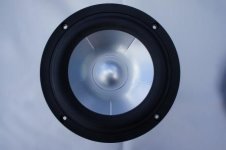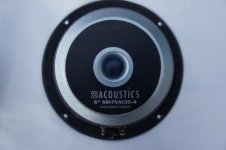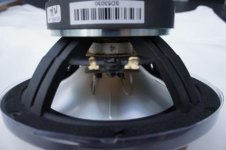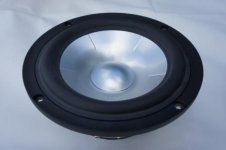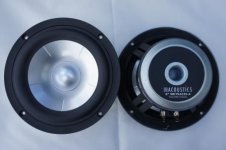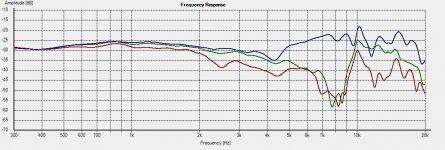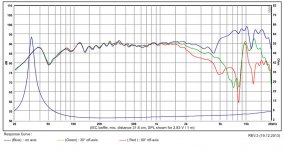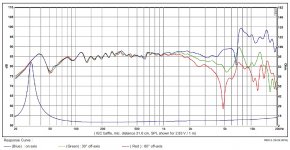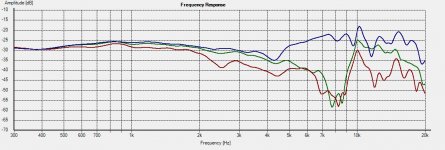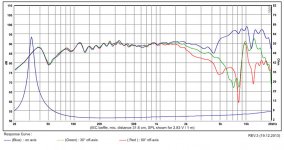Hi everyone,
I just want to share some of my measurements of the SB17NAC35-4 mid-woofer.
If you searching for a great performing hard cone mid-woofer, the SB17NAC35-4 is an excellent option.
Thanks to the cone geometry and shape, it has very good control of the cone break-up and it's a very low distorting driver.
It will be great fun working with this mid-woofer! 🙂
For details see: SB Acoustics SB17NAC35-4 Measurements!
/Göran
I just want to share some of my measurements of the SB17NAC35-4 mid-woofer.
If you searching for a great performing hard cone mid-woofer, the SB17NAC35-4 is an excellent option.
Thanks to the cone geometry and shape, it has very good control of the cone break-up and it's a very low distorting driver.
It will be great fun working with this mid-woofer! 🙂
For details see: SB Acoustics SB17NAC35-4 Measurements!
/Göran
Attachments
Wow. SB have solved the distortion amplification due to cone resonances in metal cones with their ribbed structure. The SB65WBAC also showed this but a sample of one wasn't enough to know if their bigger drivers also showed this. Now I really want a Satori version of this!
Wow. SB have solved the distortion amplification due to cone resonances in metal cones with their ribbed structure. The SB65WBAC also showed this but a sample of one wasn't enough to know if their bigger drivers also showed this. Now I really want a Satori version of this!
Yes, I was also suprised how well these slits in the cone actually works.
I intended to use them as woofers in a three-way, but given the measurement results I will also try them as mid-woofers in a two-way configuration.
Regards
/Göran
I don't know if its true, but if you trust the official measurement specifications the cone break-up seems less good on the 8 ohm version of the SB17NAC35 driver.
See attached pictures:
Picture1 = My measurements of the SB17NAC35-4 driver.
Picture2 = SB Acoustics measurements of the SB17NAC35-4 driver.
Picture3 = SB Acoustics measurements of the SB17NAC35-8 driver.
Blue = On-axis
Green = 30deg off-axis
Red = 60deg off-axis
The main cone break-up seems to appear at 7.5kHz instead of 10.2kHz for the 4 Ohm version. In fact a cone break-up at 10.2kHz is amazing for a 6" hard cone mid-woofer.
/Regards
/Göran
See attached pictures:
Picture1 = My measurements of the SB17NAC35-4 driver.
Picture2 = SB Acoustics measurements of the SB17NAC35-4 driver.
Picture3 = SB Acoustics measurements of the SB17NAC35-8 driver.
Blue = On-axis
Green = 30deg off-axis
Red = 60deg off-axis
The main cone break-up seems to appear at 7.5kHz instead of 10.2kHz for the 4 Ohm version. In fact a cone break-up at 10.2kHz is amazing for a 6" hard cone mid-woofer.
/Regards
/Göran
Attachments
Not to look a gift horse in the mouth, but are there compression measurements too?
Best,
Erik
Sorry, No!
Regards
/G
That's something I wasn't expecting, great 30degree off axis response to 4khz. Cd theoretically use with a ribbon tweet such as the viawave.
It'd be nice if they wd offer it in black, now that the OEM supply stopped (revel seem to be using a different driver)
It'd be nice if they wd offer it in black, now that the OEM supply stopped (revel seem to be using a different driver)
In your measurements there's a substantial dip at 4.2 kHz. Is this baffle diffraction related or an issue with the measurement conditions, or does the driver actually have a dip there?
In your measurements there's a substantial dip at 4.2 kHz. Is this baffle diffraction related or an issue with the measurement conditions, or does the driver actually have a dip there?
No I don't think it's the baffle. SB Acoustics use an IEC 268-5 baffle for their measurement and the dip is almost identical to mine.
/Göran
Attachments
To me this is just the typical dip with hard cones. It is based on wavelength/radiating diameter/cone profile/plug interaction. Right above this directivity suddenly starts to increase.Usually this happens a bit lower for this size drivers.
See this Klippel paper https://www.klippel.de/fileadmin/kl...ure/Papers/KLIPPEL_Sound_Radiation_Poster.pdf
This is SEAS Excel mag W16 - similar dip at 2,5kHz

See this Klippel paper https://www.klippel.de/fileadmin/kl...ure/Papers/KLIPPEL_Sound_Radiation_Poster.pdf
This is SEAS Excel mag W16 - similar dip at 2,5kHz

Now compare to one of the best 5.5" midbass drivers on the market
I'd say the SB ain't too bad.
An externally hosted image should be here but it was not working when we last tested it.
I'd say the SB ain't too bad.
Well as Juhazi says the dip is just typical of hard cones, they always have a falling response before the breakup.
Hm. Since the off-axis response dips in roughly the same way as the on-axis response, it should be fairly easy to fix with DSP.No I don't think it's the baffle. SB Acoustics use an IEC 268-5 baffle for their measurement and the dip is almost identical to mine.
/Göran
Soft paper cones typically are more shallow and because of deformations of the cone they don't show similar dip (at wavelength=radius).
I was happy to hear the lecture of Peter Larsen of LoudSoft some two years ago at AES conference. He has developed several nice simulator programs, this is a video of FINECone. I bet that the nice people at SB are familiar to this! The new midrange is a masterpiece of an achievement in cone design!
https://www.youtube.com/watch?v=nlaGb67RPwc
I was happy to hear the lecture of Peter Larsen of LoudSoft some two years ago at AES conference. He has developed several nice simulator programs, this is a video of FINECone. I bet that the nice people at SB are familiar to this! The new midrange is a masterpiece of an achievement in cone design!
https://www.youtube.com/watch?v=nlaGb67RPwc
Last edited:
5th what's the highest you'd suggest?
Personally, I would aim at no more than 2-2.5kHz.
Regards
/Göran
5th what's the highest you'd suggest?
2.5kHz if you want a directivity match to a suitable waveguide.
2kHz if to a standard dome.
People have a habit of crossing too high. If you're crossing between direct radiators then ideally you want to cross before the lower driver (in frequency) starts showing any hint of beaming. This doesn't tend to be practical when normal tweeters are concerned so it's more a case of damage limitation. The damage in this case being damage caused to the off axis response and helping to avoid the typical 'wide-narrow-wide' dispersion profile.
2kHz is a good compromise for 6" drivers, but if you can go down to 1.5kHz then all the better.
Really it depends on the system and the tweeter used. Some tweeters are very capable of crossing down at 1.5kHz whereas others aren't. The capable ones will cross at 1.5kHz and play loud until the cows come home, the less capable ones will cross that low but be uncomfortable at high playback levels.
As a stand alone 2 way the 1.5kHz could be the best option, but if you're doing a three way, or high passing the 2 way + sub, then the 2kHz xover might be the better choice, that's if you want to listen loud. Lots of tweeters are good down to 2kHz with a 4th order acoustic slope, so I see little reason in crossing higher.
- Home
- Loudspeakers
- Multi-Way
- SB Acoustics SB17NAC35-4 measurements!

